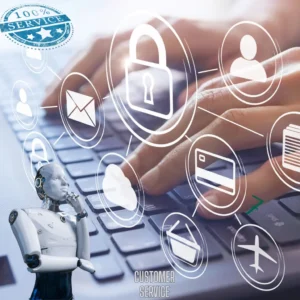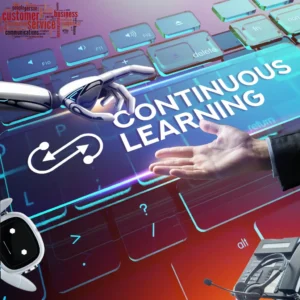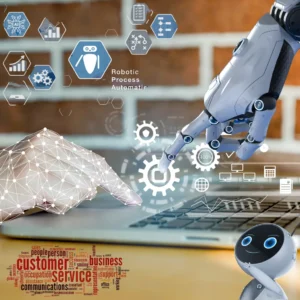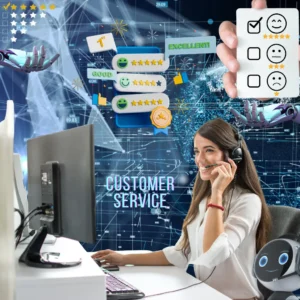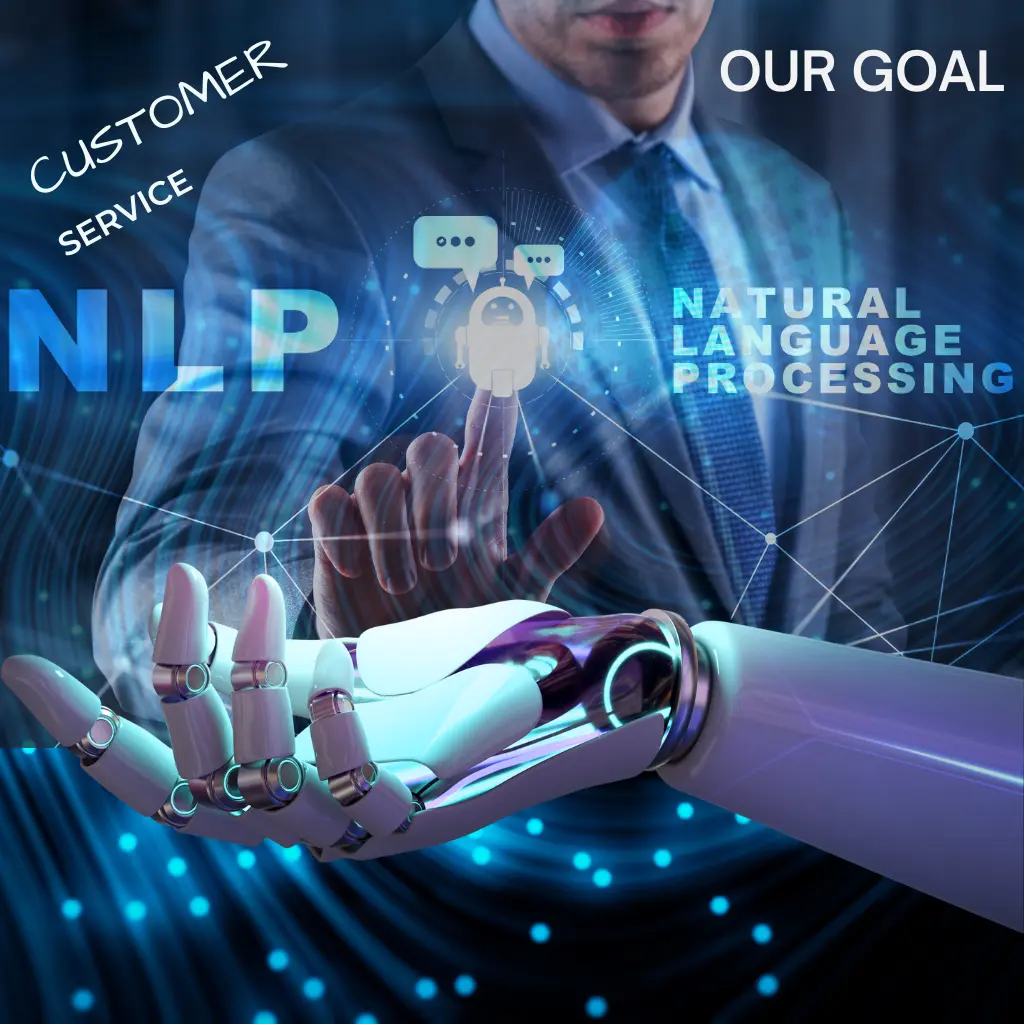
Revolutionizing Customer Experiences
Unveiling the Power of NLP Tools in Service Excellence
Embarking on a transformative journey, our 15-year legacy in the Customer Service domain propels us into a new era of innovation with the introduction of Customer Service Natural Language Processing (NLP) Tools.
As market leaders, we focus on automating processes and embracing cutting-edge AI technologies to enhance customer interactions. The suite of NLP tools encompasses sentiment analysis, chatbots, automated email responses, language translation, and content summarization, all tailored to elevate service quality.
This discussion delves into the intricate fusion of business acumen and software expertise required for successfully developing and implementing these tools, exploring the optimal balance between building from scratch, purchasing from the market, or customizing existing solutions.
Table of Contents

Arindam Roy
An Automation Consultant with 25+ years of IT Experience
5 Natural Language Processing (NLP) tool ideas for the Customer Service
Customer Service Natural Language Processing (NLP) Tools are advanced technologies designed to enhance and automate various aspects of customer service processes, leveraging the power of natural language understanding and generation. Our company developed these tools with over 15 years of expertise in the customer service domain.
1. Text-based Sentiment Analysis Tool:
This tool analyzes customer messages, emails, and reviews to discern the sentiment behind them. Using sophisticated NLP algorithms, it categorizes the text into positive, negative, or neutral sentiments. This allows businesses to gain real-time insights into customer feedback, enabling proactive responses and improvements in service quality.
2. Chatbot for Handling Customer Queries:
A Chatbot powered by cutting-edge NLP algorithms is designed to understand and respond to customer queries conversationally. With a focus on natural language understanding, the Chatbot provides instant and accurate information, resolves common issues, and guides users through various processes, ensuring a seamless and efficient customer experience.
3. Automated Email Response System:
The Automated Email Response System utilizes NLP to comprehend the content of customer emails. By understanding the context and intent of the messages, this tool generates contextually appropriate responses. This accelerates response times and ensures customers receive personalized and relevant information, enhancing overall satisfaction.
4. Language Translation Tool for Multilingual Support:
Language translation tool addresses the global nature of customer service. It employs machine translation powered by NLP. This enables businesses to communicate seamlessly with customers in multiple languages, breaking down linguistic barriers and ensuring that customer queries and concerns are understood and addressed accurately.
5. Automated Content Summarization Tool:
The Automated Content Summarization Tool is designed to condense and summarize large volumes of text content efficiently. Leveraging NLP algorithms, it extracts essential information, providing users with concise and relevant summaries. This enhances information retrieval, enabling customer service representatives to grasp crucial details and respond effectively quickly.
In summary, our Customer Service Natural Language Processing (NLP) Tools represent a comprehensive and state-of-the-art solution for businesses aiming to automate processes, enhance customer interactions, and stay ahead by integrating the latest AI technologies into their customer service operations.
Text-based sentiment analysis tool
Business Knowledge Required:
- Customer Service Domain Expertise: Understanding customer service processes, common pain points, and industry-specific nuances is crucial. A deep knowledge of customer interactions, feedback mechanisms, and service quality metrics will inform the design and optimization of the tools.
- Sentiment Analysis Expertise: A comprehensive understanding of sentiment analysis methodologies and the ability to fine-tune algorithms based on industry-specific sentiment patterns is essential. Knowledge of linguistic nuances and contextual variations in sentiment expression is crucial for accurate analysis.
Software Knowledge Needed:
- Natural Language Processing (NLP): Expertise in NLP is fundamental to developing these tools. This includes knowledge of NLP algorithms, text processing techniques, and sentiment analysis models. Proficiency in programming languages like Python and frameworks like NLTK or spaCy is essential.
- Machine Learning and AI Development: Proficiency in machine learning for chatbot and automated system development is essential. Understanding AI development, neural networks, and model training is crucial for creating robust NLP tools.
- Software Development and Integration: Skills in software development to create user interfaces, integrate APIs, and ensure seamless interactions between different components of the NLP tools. Familiarity with web development frameworks may be necessary for building user-friendly interfaces.
Hardware Needed to Run the Tools:
- High-performance Servers: Powerful servers with sufficient processing capabilities are required to process and analyze large volumes of customer data in real-time.
- GPU (Graphics Processing Unit): GPUs are essential for accelerating the training of machine learning models, ensuring faster and more efficient processing.
Training Required to Run the Tools:
- Data Annotation and Model Training: Staff will be trained in annotating data for sentiment analysis and other NLP tasks. AI specialists will be trained in continuous model improvement and adaptation to evolving language patterns.
- User Training for Tools: Customer service representatives will be trained to use the tools effectively, interpret results, and incorporate insights into their interactions.
Integrations Necessary:
- Customer Communication Channels: Integration with various customer communication channels such as email platforms, chat systems, and review platforms for real-time data ingestion.
- CRM (Customer Relationship Management) Systems: Integration with CRM systems to align NLP tools with customer data and service processes.
Comparative Tools Already Available in the Market:
- IBM Watson Natural Language Understanding: Offers sentiment analysis and other NLP capabilities.
- Google Cloud Natural Language API: Provides sentiment analysis, entity recognition, and language translation.
Recommendation:
Given the complexity and specialized knowledge required, it is recommended that these tools be built from scratch. This approach allows customization based on specific business needs and ensures alignment with existing processes.
Cost/Benefits Analysis on the Recommendation:
- Costs:
- Initial development costs may be high due to the need for specialized expertise.
- Ongoing maintenance and updates to adapt to language patterns.
- Benefits:
- Tailored solutions that align with business requirements.
- Greater control over data privacy and security.
- Long-term cost savings compared to recurring subscription fees for third-party tools.
In conclusion, investing in building Customer Service Natural Language Processing (NLP) Tools from scratch aligns with the long-term goals of maintaining market leadership, ensuring flexibility, and optimizing costs over time.
Chatbot for handling customer queries
Business Knowledge Required:
- Customer Service Processes and Practices: It is crucial to deeply understand your company’s customer service workflows, common queries, and typical customer interactions. Knowledge of pain points and areas where automation can enhance efficiency is also essential.
- Industry-Specific Language Understanding: The Chatbot must be familiar with industry-specific terminology and customer inquiries to ensure it can effectively comprehend and respond to context-specific queries.
Software Knowledge Needed:
- Natural Language Processing (NLP): Expertise in NLP algorithms, sentiment analysis, and intent recognition to enable the Chatbot to understand and interpret queries accurately.
- Machine Learning and AI Development: Proficiency in machine learning techniques for training the Chatbot, including natural language understanding, dialogue flow management, and reinforcement learning for continuous improvement.
- Programming Languages and Frameworks: Strong programming skills, particularly in languages like Python, and knowledge of frameworks like TensorFlow or PyTorch for developing and deploying machine learning models.
Hardware Needed to Run the Tools:
- Cloud Infrastructure: Utilizing cloud-based infrastructure for scalable and flexible deployment, ensuring the Chatbot can handle varying workloads efficiently.
- Web Servers: Reliable web servers to host the Chatbot and handle user interactions securely and in real-time.
Training Required to Run the Tools:
- NLP Model Training: Training data scientists or AI specialists to continually improve and update NLP models to improve their accuracy and understanding of customer queries.
- Chatbot Usage Training: Customer service representatives will be trained on using and supervising the Chatbot, ensuring seamless integration into existing workflows.
Integrations Necessary:
- Customer Interaction Channels: Integrate with various customer communication channels, such as website chat, social media, and messaging apps, to ensure consistent and omnichannel support.
- CRM (Customer Relationship Management) Systems: Integration with CRM systems to access customer data and history and provide personalized responses.
Comparative Tools Already Available in the Market:
- Dialogflow by Google: A popular tool for building conversational interfaces using NLP and machine learning.
- Microsoft Azure Bot Service: Offers a comprehensive platform for building intelligent bots using NLP and AI.
Recommendation:
Considering the complexity and specialized expertise required, buying and customizing an existing solution is recommended. This approach allows for leveraging proven technologies while tailoring the Chatbot to specific business needs.
Cost/Benefits Analysis on the Recommendation:
- Costs:
- Initial acquisition costs may be lower compared to building from scratch.
- Customization costs to align the Chatbot with specific business requirements.
- Benefits:
- Faster implementation and time-to-market.
- Access to a mature and tested solution.
- Ongoing support and updates from the vendor.
In conclusion, acquiring and customizing a chatbot from the market aligns with efficiently leveraging AI technologies, ensuring rapid deployment, and reducing the initial development burden.
Automated Email Response System
Business Knowledge Required:
- Email Customer Interaction Patterns: Understanding the typical patterns of customer inquiries, issues, and requests received through emails is crucial for effective NLP implementation. Knowledge of the typical language used in customer emails is vital.
- Brand Voice and Tone Guidelines: Familiarity with the company’s brand voice and tone to ensure that automated responses align with the organization’s communication style and values.
Software Knowledge Needed:
- Natural Language Processing (NLP): In-depth knowledge of NLP techniques, particularly those related to email text analysis, sentiment recognition, and context understanding. This includes entity recognition for extracting essential information.
- Machine Learning and Text Generation: Proficiency in machine learning models, especially those for text generation. This includes creating models that understand context and generate contextually appropriate responses.
- Email Parsing and Processing: Expertise in email parsing to extract relevant information from customer emails and integrate it with the NLP models. Knowledge of email handling libraries or APIs is essential.
Hardware Needed to Run the Tools:
- Cloud Infrastructure: Leveraging cloud-based infrastructure for scalable deployment, ensuring the system can handle varying email volumes efficiently.
- Server Capacity: Adequate capacity to process and analyze emails in real-time, especially during peak periods.
Training Required to Run the Tools:
- NLP Model Training: Training data scientists or AI specialists to continually improve and update the NLP models for better accuracy in understanding customer emails.
- Customization Training: Training customer service representatives to customize and optimize the automated responses based on specific situations and feedback.
Integrations Necessary:
- Email Platforms: Integration with the company’s email platform to seamlessly process and respond to incoming customer emails.
- CRM (Customer Relationship Management) Systems: Integration with CRM systems to access customer information and history and provide personalized and contextually relevant responses.
Comparative Tools Already Available in the Market:
- Zendesk Reply: Offers automated email responses with some degree of customization.
- Freshdesk: Provides automated ticketing and responses using NLP for email communication.
Recommendation:
Considering the specialized knowledge and potential complexity involved, it is recommended that an existing solution be bought and customized. This approach allows leveraging proven technologies while tailoring the Automated Email Response System to specific business requirements.
Cost/Benefits Analysis on the Recommendation:
- Costs:
- Lower initial acquisition costs compared to building from scratch.
- Customization costs to align the system with specific business needs.
- Benefits:
- Faster implementation and time-to-market.
- Access to a mature and tested solution.
- Ongoing support and updates from the vendor.
In conclusion, acquiring and customizing an Automated Email Response System from the market aligns with efficiently implementing AI technologies in customer service, ensuring rapid deployment, and reducing the initial development burden.
Language Translation Tool for Multilingual Support
Business Knowledge Required:
- Multilingual Customer Service Understanding: A deep understanding of the diverse languages spoken by your customer base is crucial for effective translation. Knowledge of common queries, cultural nuances, and expectations in different languages is vital.
- Regulatory and Compliance Knowledge: Awareness of legal or compliance requirements related to language translation, especially in industries with specific regulations.
Software Knowledge Needed:
- Natural Language Processing (NLP): In-depth knowledge of NLP algorithms, particularly those related to machine translation and language understanding. Understanding language syntax, semantics, and linguistic variations is essential.
- Machine Translation Models: Proficiency in machine translation models and frameworks, such as Google’s Translate API or OpenNMT, for building accurate and context-aware translation systems.
- Programming Languages: Strong programming skills, particularly in languages like Python, and familiarity with relevant frameworks for implementing machine translation models.
Hardware Needed to Run the Tools:
- Cloud Infrastructure: Utilizing cloud-based infrastructure for scalable deployment, ensuring the translation tool can handle diverse language pairs efficiently.
- High-speed Network Connection: A robust network connection to facilitate real-time translation, especially when dealing with large volumes of text.
Training Required to Run the Tools:
- Data Annotation and Model Training: Training data scientists or linguists to annotate data to train machine translation models and improve accuracy.
- User Training for Multilingual Support: Training customer service representatives on effectively using the language-translation tool, ensuring accurate and culturally sensitive communication.
Integrations Necessary:
- Customer Communication Channels: Integration with various customer communication channels such as chat, email, and social media to provide seamless multilingual support.
- CRM (Customer Relationship Management) Systems: Integration with CRM systems to align multilingual interactions with customer data and service processes.
Comparative Tools Already Available in the Market:
- Google Cloud Translation API: Offers machine translation services with support for a wide range of languages.
- Microsoft Translator: Provides language translation services, including real-time translation for customer interactions.
Recommendation:
Given the complexity and specialized knowledge required, it is recommended that an existing solution be bought and customized. This approach allows leveraging proven technologies while tailoring the language-translation tool to specific business requirements.
Cost/Benefits Analysis on the Recommendation:
- Costs:
- Lower initial acquisition costs compared to building from scratch.
- Customization costs to align the tool with specific business needs.
- Benefits:
- Faster implementation and time-to-market.
- Access to a mature and tested solution.
- Ongoing support and updates from the vendor.
In conclusion, acquiring and customizing a Language Translation Tool from the market aligns with efficiently implementing AI technologies in customer service, ensuring rapid deployment and reducing the initial development burden.
Automated Content Summarization Tool
Business Knowledge Required:
- Content Understanding and Context: A profound understanding of the specific content types within the customer service domain, including standard language patterns, essential information, and context. This knowledge ensures that the automated summarization tool captures and highlights relevant details.
- User Behavior and Preferences: Insight into customer behaviour and preferences regarding information retrieval. Understanding how users consume summarized content enhances the tool’s effectiveness in delivering valuable insights.
Software Knowledge Needed:
- Natural Language Processing (NLP): In-depth knowledge of NLP algorithms, especially those related to text summarization, entity recognition, and context extraction. Proficiency in leveraging algorithms like TextRank or BERT for effective content summarization.
- Text Processing and Analysis: Expertise in text processing techniques, including tokenization, part-of-speech tagging, and syntactic analysis, to extract meaningful summarization information.
- Programming Languages and Frameworks: Strong programming skills, particularly in languages like Python, and familiarity with NLP frameworks (e.g., spaCy, NLTK) for tool development.
Hardware Needed to Run the Tools:
- Cloud Infrastructure: Utilizing cloud-based infrastructure for scalable deployment, ensuring the tool can process large volumes of text efficiently.
- Sufficient Processing Power: Adequate processing power to handle complex NLP algorithms, especially when summarizing extensive text data.
Training Required to Run the Tools:
- NLP Model Training: Training data scientists or NLP specialists to fine-tune algorithms ensures that the summarization tool provides accurate and contextually relevant summaries.
- User Training for Tool Utilization: Train customer service representatives to effectively use and interpret the automated content summarization tool.
Integrations Necessary:
- Data Sources and Repositories: Integration with relevant data sources, databases, or repositories containing the text data to be summarized.
- CRM (Customer Relationship Management) Systems: Integration with CRM systems to align summarized content with customer data and service processes.
Comparative Tools Already Available in the Market:
- Summarizer Tools by OpenAI: Offers advanced summarization capabilities using transformer-based models.
- TextTeaser: Provides an API for text summarization using NLP algorithms.
Recommendation:
Given the specialized knowledge required, it is recommended that the Automated Content Summarization Tool be built from scratch. This approach allows for tailoring the tool to the specific needs of the customer service domain and ensuring optimal performance.
Cost/Benefits Analysis on the Recommendation:
- Costs:
- Higher initial development costs due to specialized knowledge and customization.
- Lower long-term costs as there are no recurring licensing fees.
- Benefits:
- Tailored solutions aligned with specific business requirements.
- Greater control over data privacy and security.
- Long-term cost savings compared to recurring subscription fees for third-party tools.
In conclusion, building the Automated Content Summarization Tool from scratch aligns with the intent to maintain market leadership through innovation and customization, ensuring the tool addresses the unique needs of the customer service domain.
Conclusion
In conclusion, integrating Customer Service Natural Language Processing (NLP) Tools represents a pivotal step for our company. We are leveraging 15 years of expertise in the customer service domain to elevate service quality and operational efficiency. The suite of NLP tools, including sentiment analysis, chatbots, automated email response systems, language translation, and content summarization, underscores our commitment to embracing cutting-edge AI technologies.
These tools, designed to streamline customer interactions and automate critical processes, empower our customer service representatives to deliver a seamless, personalized, multilingual experience. The intricate balance between business acumen and software proficiency is vital for successfully developing and deploying these tools. Understanding customer behaviour, linguistic nuances, and industry-specific requirements form the foundation for our NLP tools.
The decision-making process, whether to build from scratch, buy from the market, or customize existing solutions, is guided by a strategic approach that considers the complexities of each tool. While building from scratch ensures tailored solutions aligned with our business needs, buying and customizing existing tools offer a balance between efficiency and flexibility.
In embracing these Customer Service Natural Language Processing (NLP) Tools, we position ourselves at the forefront of technological innovation, catering to the dynamic landscape of customer service. Adopting these tools enhances our operational capabilities and reinforces our commitment to providing unparalleled customer experiences in an ever-evolving market.
Related Articles
- 50 AI Tools for the Customer Services Domain
- 5 Facial Recognition and Emotion Analysis Tools of Customer Service
- 5 Customer Service Speech Recognition and Processing Tools
- 5 Customer Service Predictive Analytics and Recommendation
- 5 Customer Service Tolls for Automation and RPA
- 5 Customer Service Tools for Knowledge Management
- 5 Customer Service Tools for Continuous Learning and Improvement
- 5 Customer Service Tools for Customer Survey Analysis
- 5 Customer Service Tools for Social Media Monitoring
- 5 Customer Service Tools for Data Security and Privacy

